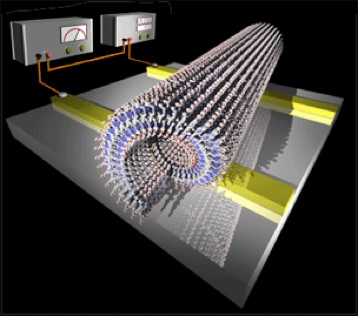An amphiphilic hexa-peri-hexabenzocoronene self-assembles to form a π-electronic, discrete nanotubular object. The object is characterized by an aspect ratio greater than 1000 and has a uniform, 14-nanometer-wide, open-ended hollow space, which is an order of magnitude larger than those of carbon nanotubes. The wall is 3 nanometers thick and consists of helical arrays of the π-stacked graphene molecule, whose exterior and interior surfaces are covered by hydrophilic triethylene glycol chains. The graphitic nanotube is redox active, and a single piece of the nanotube across 180-nanometer-gap electrodes shows, upon oxidation, an electrical conductivity of 2.5 megohms at 285 kelvin. This family of molecularly engineered graphite with a one-dimensional tubular shape and a chemically accessible surface constitutes an important step toward molecular electronics.
Self-Assembled Hexa-peri-hexabenzocoronene Graphitic Nanotube.
Jonathan P. Hill, Wusong Jin, Atsuko Kosaka, Takanori Fukushima, Hideki Ichihara, Takeshi Shimomura, Kohzo Ito, Tomihiro Hashizume, Noriyuki Ishii, and Takuzo Aida

Highlighted in C&EN
Science 2004, 304, 1481–1483.
Conductive Helical Nanotubes of Molecular Graphene